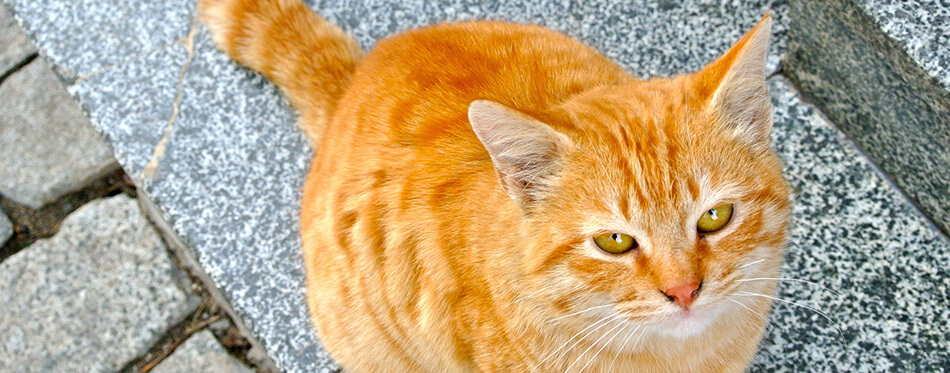While cats may appear to be cool customers, they are actually naturally warm creatures, with their body temperature several degrees hotter than humans. Which is why, when stroking or cuddling your cat, you may feel that their ears are hot, but it doesn’t necessarily mean something is wrong.
However, as pet parents, we must be ever vigilant when it comes to our felines’ health and wellbeing. So, to help you decide whether your cat may be sick or is just ‘hot stuff’, we investigate further to answer the question – ‘my cat’s ears are hot – is this normal?’

Human V Cat Body Temperature
Cats are warm-blooded creatures that have a higher core body temperature than us. While the ideal body temperature for humans is between 97 and 99 degrees Fahrenheit, your kit takes it up a notch. A healthy cat’s body temperature is actually between 100.5 and 102.5 degrees Fahrenheit, making a temperature difference of up to 5.5 degrees. And it is this difference, although small, which can make you think your cat is running a fever. When stroking your cat, your hands are cooler than he is, meaning his warmer temperature will be noticeable as you pet him. And this can be easy to misinterpret and think that something might be wrong.
You may also like our article on Vitamins For Cats.
About Your Cat’s Ears
The key to knowing when things are normal and when something may be a little untoward when feeling the temperature of your cat’s ears, is to know a little more about their make-up. Unlike most of your cat’s body, the surface area of their ears is thin and usually exposed, in that they are not protected by masses of fur or body fat. This means the temperature of the cat ear can fluctuate in response to their surroundings. The same thing also happens to their nose, which is similarly exposed.
Blood flow to their ears can also help to control their body temperature. The thin surface area of the skin on the ears is full of tiny veins that constrict or expand as needed. This means that during warm weather, the veins ‘vasodilate’ to increase blood flow to the ears, helping to release excess body heat. During the winter or cold weather, the opposite happens – the veins ‘vasoconstrict’ to help prevent heat loss and conserve your cat’s body temperature to keep your cat warm.
If your cat is a sun lover who frequently basks when the sun is out, the temperature of his ears will also fluctuate, especially if he has been basking for a little too long. When he returns inside, his hot ears should quickly return to a more normal temperature. The same temporarily rise in ear temperature can occur if he likes to spend too much time snuggled near the fire or radiator.
Taking Your Cat’s Temperature
If you are concerned about your cat’s temperature, or his hot ear doesn’t dispel when you take him away from an external heat source, you may want to take his temperature just to be sure. As his ears are on the outside of his body, they will be a little cooler than his inner core temperature, and it is this reading that matters when deciding if there is a more serious problem.
A rectal thermometer is the best way to take your cat’s temperature at home as they are more accurate than ear thermometers. A digital thermometer will also give you a much quicker reading, making the process easier for both you and your cat. When evaluating the reading, keep in mind your cat’s normal body temperature range of 100.5°F and 102.5°F.
Potential Causes of ‘Hot Ears’
If you detect a hot ear in your cat and it doesn’t dispel when his surrounding environment is at a room temperature that is not too hot or cold, then there can be several reasons why it is still feeling on the warm side. We take a look at the main causes of hot ear:
Fever – a fever is probably the first thing you will think of when it comes to noticing a temperature rise in your kit’s ears. To put your mind at ease, your cat can have a mild fever – where his body temperature rises to above 103 degrees – and shouldn’t be anything to worry about. A slight increase in body temperature is a sign his body’s immune system is kicking into action to tackle any minor infections or bugs he may have picked up. With a mild fever, the symptoms should soon clear up and your cat will also take its own healing interventions, such as moving to a cooler spot in the room. In these cases, monitor your cat, and ensure they have access to plenty of fresh water and food.
A noticeably higher temperature – above 103 degrees – and you may see other symptoms of a fever, including lethargy and loss of appetite. If their temperature does rise and they seem off in other ways, a trip to the vet is always a good idea to get them checked out.
Allergies – hot ears, especially if accompanied by redness, can be a sign of an allergy. In humans, allergies often manifest with respiratory symptoms as one of the main indicators, but in both dogs and cats, they can show in a different way. A common indication that your cat may have an allergy is a reaction in their ears as well as on their skin. Hot ears can be caused by a host of allergens, including fleas, diet or allergens in their environment. Your cat may also be observed scratching their head and face more than normal as well as rubbing their head across their carper, in a bid to get a little relief. If you suspect an allergy may be causing your cat’s hot ears, your vet can run further tests and recommend a treatment plan to ease those irritating symptoms.
Ear mites – another potential trigger for hot ears could be ear mites. These miniscule parasites can crawl into your kit’s ear canals, feeding off loose skin and any debris inside the ear. And they will certainly let your cat know they have set up home! Your cat’s inner ears will become extremely itchy, leading to your cat persistently scratching to get some relief. This scratching can then lead to further inflammation in the ears, making them red and feel hot to the touch. If you suspect ear mites, take a peek inside your cat’s ears and you will most likely see a build-up on debris and small brown particles. Left untreated your kit could develop a more serious ear infection so speak to your vet, as ear mites are easy to treat.
Infection – your cat’s ears are delicate organs and can be susceptible to infections, both in the outer and inner ear. Wax, foreign objects, bacteria, untreated allergens, mites or poor hygiene can all lead to an infection inside your cat’s ear, which left untreated can lead to more serious damage, including affecting their ear drum. As well as noticeably hot ears, other signs your kit may well have an ear infection, include excessive scratching, head shaking, inflammation and redness. It is important to get your vet to check out your cat to prevent any infection leading to permanent damage.
Hyperthyroidism – one specific health condition which can cause a temperature rise in your cat is hyperthyroidism – or an overactive thyroid gland. One of the most common conditions to affect more senior cats, hyperthyroidism causes an increase in their metabolism. As well as weight loss, increase appetite and restlessness, this increase can also result in an elevated heart rate, raising your older cat’s body temperature. If your senior feline persistently presents with hot ears as well as any or all of the other symptoms of the condition, make an appointment with your veterinarian so a formal diagnosis can be made. Left untreated, hyperthyroidism can lead to hypertension and heart failure, so it is essential to get your cat checked out if you suspect this condition.
Related Post: Cat Calming Sprays

What to Do If you Think Your Cat is Sick
So, now we have run through your cat’s body temperature, how their ears help them to regulate their own body heat and the possible causes of hot ears, you will hopefully be well-equipped to decide if your cat’s warmer than normal auditory apparatus is normal or needs further investigation.
If you have ruled out environmental factors or mild allergies and after taking their body temperature you still suspect cat’s hot ears are a sign that all may not be well, then check him for other symptoms, including:
- Listlessness or lethargy
- Disinterest in you and his surroundings
- A reduction in his appetite
- Constipation and/or diarrhea
- Vomiting
- A raised heartbeat
- Rapid breathing
- Shivering
- Signs he may be in pain
All these are symptoms of a sick cat and so you need to seek professional veterinary advice as soon as possible. With the cause correctly diagnosed, and the appropriate treatment plan started, you should soon be back to petting your cool-eared feline.

